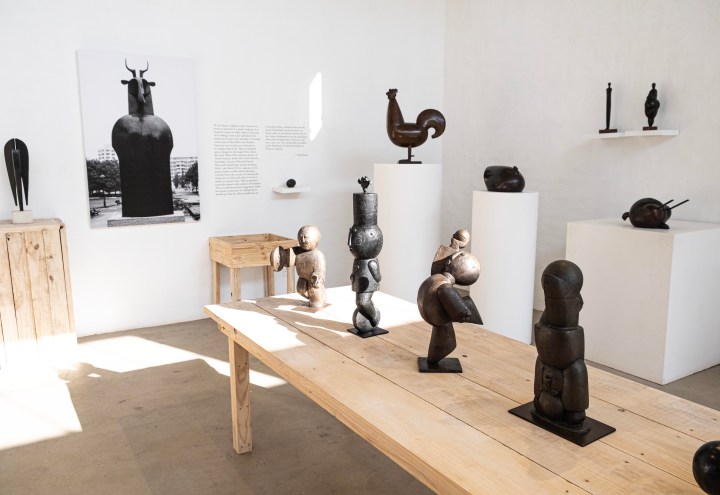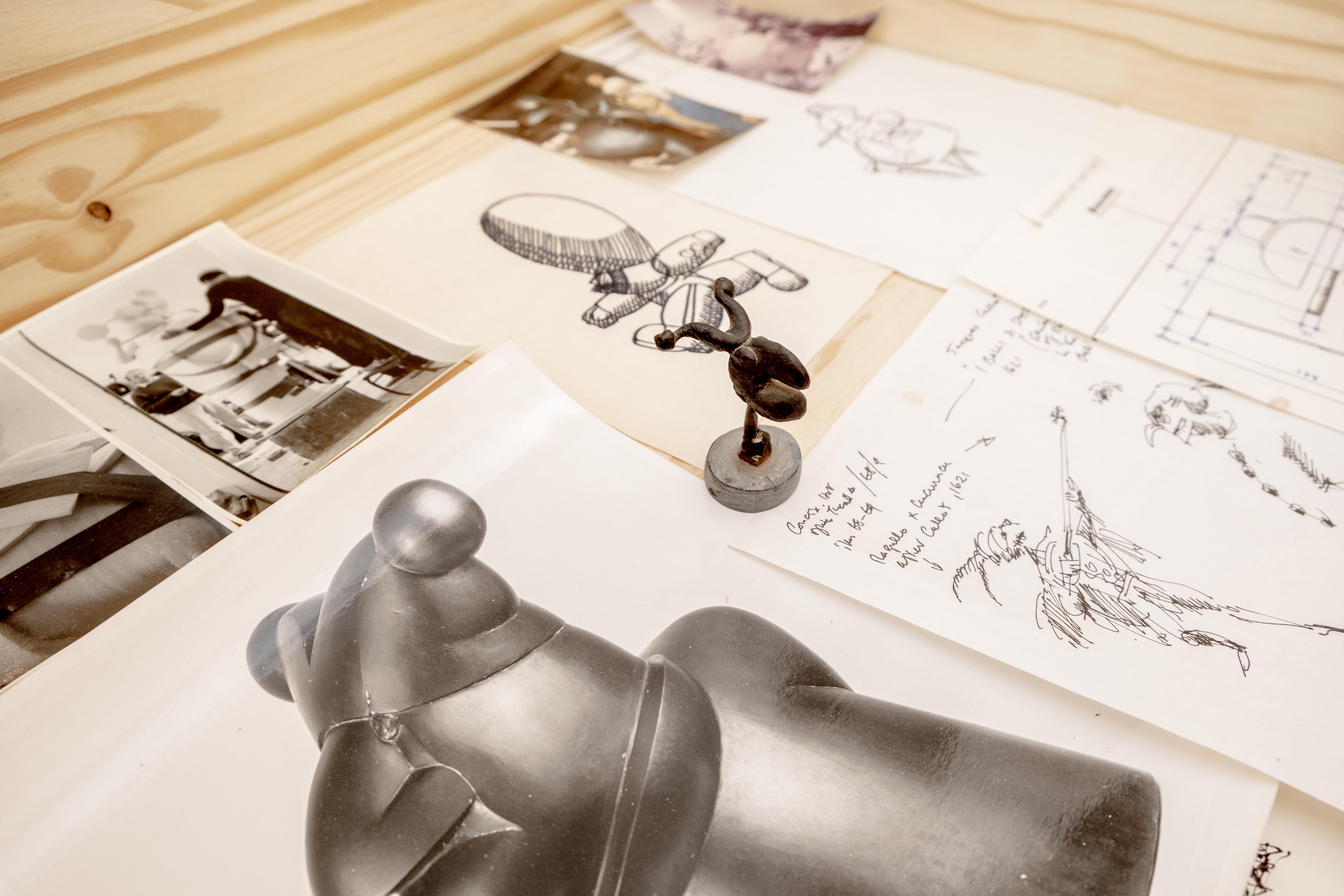MATTERS OF THE ART
Into the Megatext: Chronicling the life and work of South African sculptor Bruce Arnott

The exhibition is a chance to engage with Arnott’s work up close – to consider the groundedness of his sculptures, the rounded, graphic quality of his forms and the subtle, but certain use of mark-making to convey a particular sense of character.
There is the Sphinx outside Cape Town’s Baxter Theatre, of course, and the Alma Mater sculpture installed on UCT’s Middle Campus, but it was only halfway through Into the Megatext, a new publication on the late South African artist and academic Bruce Arnott, when I realised that I’d encountered another of his public works many times before.
Blacksmith is a large bronze sculpture that sits outside the entrance of the 1820 Settlers Monument in Makhanda. It depicts a figure, knees slightly bent and hammer raised above his head, wearing an extravagant moustache and bowler hat.
I must have first seen it in 2012, during my time at the University Currently Known as Rhodes. It’s probably in the background of a few of my graduation photos, too. Since then, I’ve unintentionally engaged with Arnott’s sculpture at least once a year, on an annual visit to Makhanda to cover the National Arts Festival. Later this month, in fact, as I’m on my way to see an exhibition or a performance up at the monument, or collecting my lanyard and tote bag at the media desk, I’ll pass Arnott’s hammer-wielding sculpture.
To be honest, I never thought much of it until now. Like the building it stands before, I found the sculpture to be at odds with itself, full of the suggestion of movement – arms ready to bring the hammer crashing down – but with an awkward and unyielding form. It turns out I was mostly right.
Blend of irony and socialist-realist art
Reflecting on the sculpture, which was commissioned by the 1820s Foundation and installed in 1986, Arnott writes that Blacksmith is “an idealised concept, a conscious (if ironic) reference to socialist-realist art is intended – in the exploitation of a traditional heroic stance and massive stylised forms. However, I endeavoured to compromise heroic solemnity by making allusions to the theatrical posturing and handle-bar moustaches of that real nineteenth-century popular hero, the pugilist or prize-fighter; and by introducing a sort of stiffness and bowler-hatted formality that might be construed as quintessentially English”.
This playful, but intentional engagement with the complexity, continuity and simultaneity of history, and of contemporary life, was central to Arnott’s work. This much is evident in both the exhibition of his work currently on at the Villa-Legodi Centre for Sculpture at NIROX, and in the publication itself.

A vitrine displaying archival material at the Bruce Murray Arnott: Into the Megatext exhibition at Villa-Legodi Centre for Sculpture at NIROX. (Photo: Sven Christian)
One of the recurring observations in Into the Megatext, edited by Mari Lecanides-Arnott and Sven Christian, is that Arnott was always aware of his work, be it a large-scale public commission or the smaller pieces that populate many university, museum and private collections, as being part of a greater conversation. “All sculptures are ‘points of entry’ into the great sculptural megatext,” Arnott said in his 2003 inaugural lecture at the University of Cape Town. It’s the line that informed the title and central themes of Ashraf Jamal’s essay on the artist, and subsequently the title of the publication itself.
In this way, sculpture was the perfect medium for Arnott, providing him with a rootedness to his otherwise roving, multifaceted practice and mind. Through his work, he managed to strike a balance between the poetic and the pragmatic, undercutting the sombreness or the complexity of his subject matter with a certain levity. This is evident in works like Blacksmith and his series of Punch sculptures; but as the book shows us, it was a quality that also characterised much of his writing and thinking.
Engaging and edifying
In Shaping Ideas: the Visual Forming of Meaning, one of nine Arnott texts featured in Into the Megatext, his definition of sculpture is both engaging and edifying.
“A sculpture has been defined as – ‘something you bump into when you stand back to look at a painting’. Nowadays the thing that you tread in when you step back to admire a sculpture might very well be a painting, or a print in the form of a frozen chicken or a chocolate body part. That is good. Such developments extend the boundaries of art. Nevertheless, that old definition of sculpture is more useful than one might suppose, because it emphasises the qualities of ‘solidity’ and ‘thingness’ that still describe the essentials of the art form. It reminds us that sculpture is fundamentally concerned with mass (therefore with gravity), with volume (therefore with space), with the object (therefore with materiality and identity).”
Citizen (1986), which stands on its comically spindly legs outside the Johannesburg Art Gallery and regularly had its more malleable parts liberated and sold, is one of the better-known examples of Arnott’s shrewd humour. Top-heavy with his fat cigar, stick-thin cane, and his enormous stomach, Citizen is almost made to be toppled.
Arnott describes Citizen as “an ironic gloss of the genre of the heroic monumental statue”, made in response to Anton van Wouw’s statue of Paul Kruger in Pretoria. “With a top hat, coat tails, a cane in his right hand and a rolled-up parchment in his left,” writes Christian, “the statue of Kruger is a clear departure point, yet where Kruger is depicted as a mighty and broad-shouldered figure, the master of all that he surveys, Arnott’s figure is mock-defeatist, self-described as a ‘modern day condottiere, without a horse’.”
Valuable resources
At the launch of Into the Megatext, which took place at the Villa-Legodi Centre for Sculpture on Sunday 28 May, Christian explained how the exhibition grew out of the book, as opposed to the book being written in response to the exhibited works, as is often the case. Both are hugely valuable resources. The book, which contains essays from a number of authors, texts by Arnott himself and an extensive catalogue of his sculptures, offers myriad ways of making sense of the artist’s life and work, including his time spent constructing Haycroft, the family farmhouse in the Underberg district of KwaZulu-Natal, where he lived from 1972 to 1978, and where he produced Numinous Beast, installed in front of the Iziko South African National Gallery in 1979.
The exhibition, curated by Christian, is a chance to engage with the work up close – to consider the groundedness of Arnott’s sculptures, the rounded, graphic quality of his forms and the subtle, but certain use of mark-making to convey a particular sense of character.
Many of Arnott’s original notes and drawings are also included in the exhibition, displayed in vitrines or loosely gathered in open crates alongside black and white images of him and his work. These documents and drawings provide another point of entry into Arnott’s process of making and thinking.
‘Integral part of the process’
As Lecanides-Arnott reminds us: “[Arnott] considered drawing to be an integral part of the creative process … More than a technique for problem solving, however, he believed drawing to be the primary act through which ideas are realised and developed … In the context of drawing, seeing does not just mean looking, but observing, understanding, experiencing, remembering, thinking and making.”
Importantly, the exhibition and publication are, after Arnott, attentive to history while remaining firmly rooted in contemporary life. They are not only comprehensive records of Arnott’s career and legacy, they’re also examples of how we can continue to ensure that a record of South African contemporary artists like Arnott exists outside of academic or commercial art spaces.
As Jamal put it at the launch: “There is a major global, primarily western, interest in our African Modernist artists, of which Bruce would be a great example. People who are on the verge of being neglected or being erased from our history are being brought back into not only national history, but global history.” DM
Into the Megatext is on exhibition at the Villa-Legodi Centre for Sculpture at NIROX until 26 June 2023.






 Become an Insider
Become an Insider
Comments - Please login in order to comment.